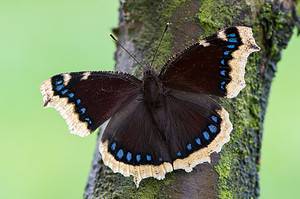Spring is a great time to watch and photograph all the flying insects that visit your garden. If you’ve recently spotted a black and white butterfly but don’t know what species it is, keep reading. We’ve created a list of 20 black and white butterflies with pictures to help you identify the ones you find.
Butterflies are excellent pollinators, and there are over 20,000 species of them in the world. Scientists are still finding new species, with the most recent new type discovered in 2018. Butterflies have the ability to see ultraviolet light, a trait they share with a few other creatures including bees and reindeer.
This helps them send messages to each other, and many butterflies have ultraviolet colors hidden in their wings to attract mates. Seeing UV light also means that some species of butterflies prefer certain colors of flowers. With so many amazing types of these flying insects, it’s fun to identify the exact species they are.
Cabbage White
The cabbage white butterfly species is native to Eurasia and Africa and also lives in North America, where they were introduced around 1860. True to their name, the caterpillars of this species live and feed on cabbage, broccoli, kale, and other cruciferous plants. For this reason, some people view their larvae as pests before they reach adulthood and become butterflies.
They are medium in size with a wingspan of 1.3 to 1.9 inches. Cabbage white butterflies have all-white or cream bodies. The males have one black dot on each wing, and the females have two.
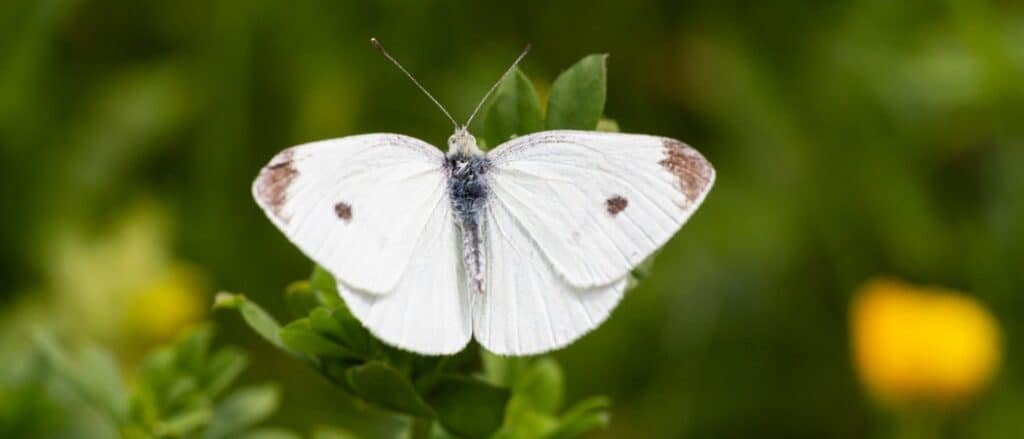
Cabbage
white butterfly
with wings open on a leaf.
©iStock.com/Maya Jane
Zebra Swallowtail
This butterfly species is native to the eastern U.S. and Canada. Zebra swallowtails have vertically-running black and white stripes across their entire bodies similar to that of a zebra. They also have a small red dot at the bottom of their hindwings, right before their tails. Their tails are long and sword-like. These are large butterflies with an average wingspan of 2.5 to 4.1 inches.
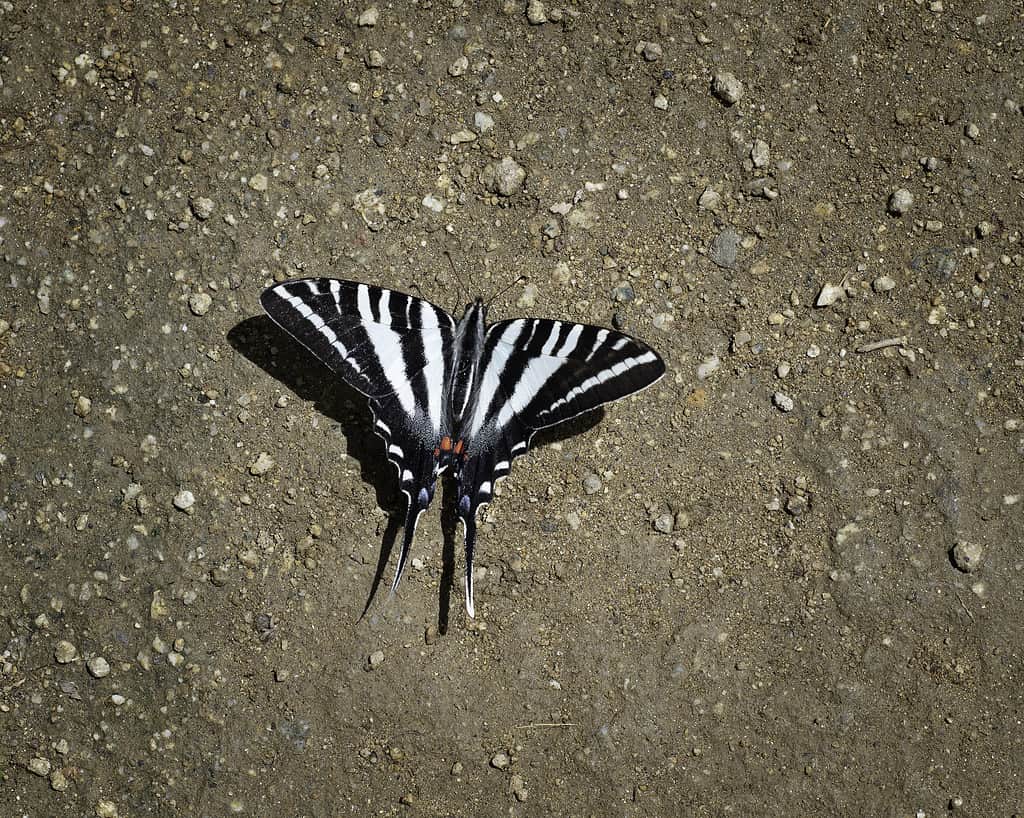
A close-up of a Zebra Swallowtail butterfly sunbathing.
©iStock.com/GDMatt66
Zebra Longwing
Zebra longwings are very similar in appearance to zebra swallowtail butterflies. They have a pattern of black and white (and sometimes yellow) stripes that resemble a zebra, but longwing butterflies have a more crisp appearance. While zebra swallowtail colors fade into one another, zebra longwing colors have clear edges and lines. This species lives in Mexico and Central America, as well as parts of the U.S. including Texas and Florida. They are a long-living species of butterfly, living and producing eggs for several months rather than weeks. They have a wingspan of 2.8 to 3.9 inches.

Zebra longwing butterflies have crisp black and white stripes.
©Colin Eaton/Shutterstock.com
Marbled White
The marbled white species are black with many large white spots and a white outline around their wings. Males are usually the darker black color, while females can be brown. This species is unique for its preference of purple flowers. Because of this, they often visit gardens and residential areas. Marbled white butterflies are a medium size, with a wingspan of 2.1 to 2.3 inches.
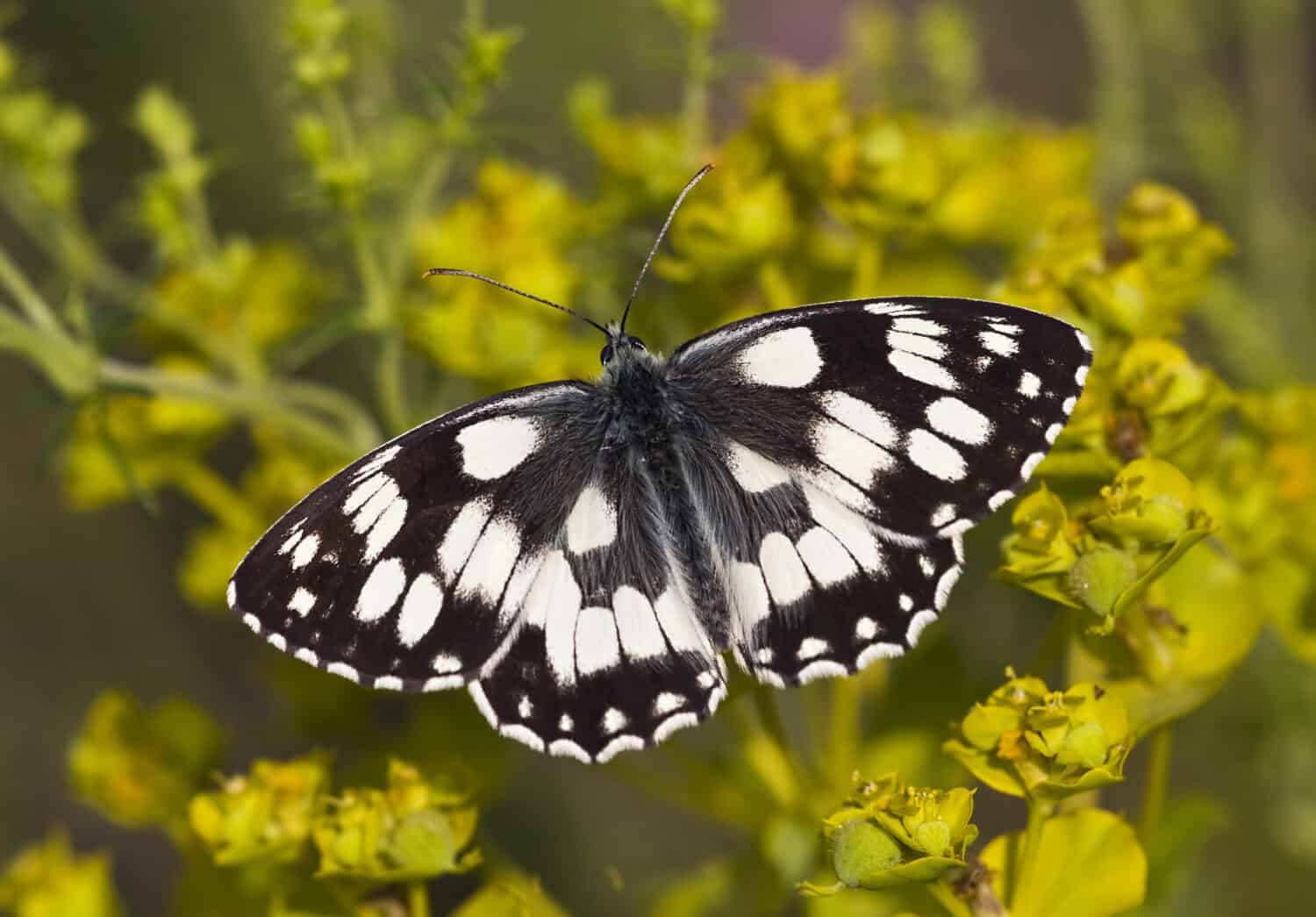
Marbled white butterflies are black with many large white spots and a white outline around their wings.
©Reddogs/Shutterstock.com
White Admiral
White admiral butterflies are found across Europe and much of North America. They love the sun and can often be found resting on the highest points of trees. White admirals are medium to large butterflies with an average wingspan of 3 inches. They are easily recognizable by their black bodies and wings that have a large white band that runs horizontally.

These butterflies are black with a white band running across their wings.
©Erni/Shutterstock.com
Pale Swallowtail
The pale swallowtail is found across western North America, usually in California. Their wings have alternating black and white stripes that run across them. They are similar in appearance to the zebra swallowtail, but more white in color. They also have two long tails that extend from the bottom of their hindwings. Pale swallowtails have a wingspan of 2.5-3.5 inches.
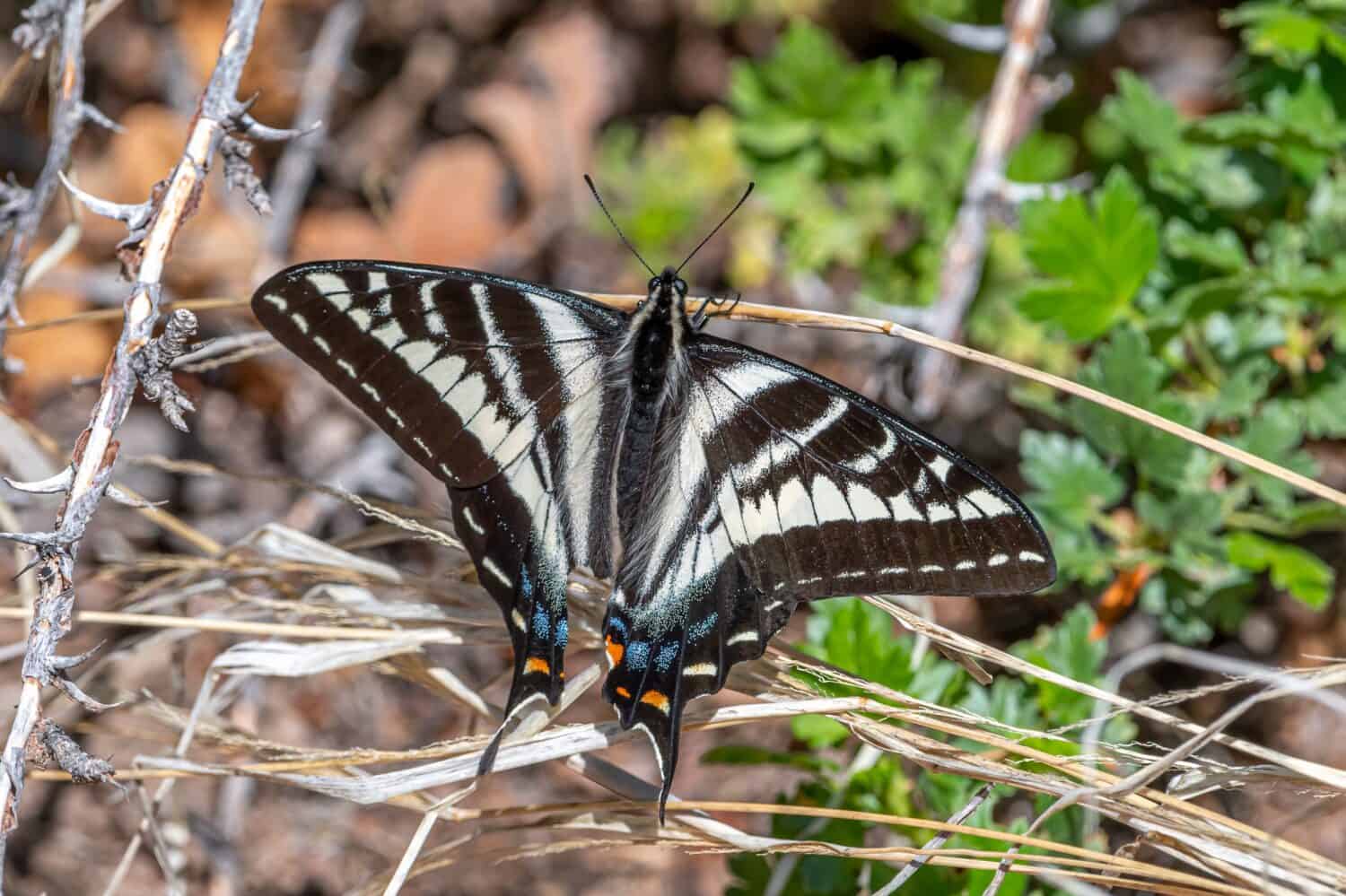
A pale swallowtail butterfly resting on a piece of foliage.
©Gerald A. DeBoer/Shutterstock.com
Grizzled Skipper
The grizzled skipper species is native to Europe and commonly lives in parts of England and Wales. These butterflies have black wings with white checkerboard spots. They are a small species with an average wingspan of just 1 inch.
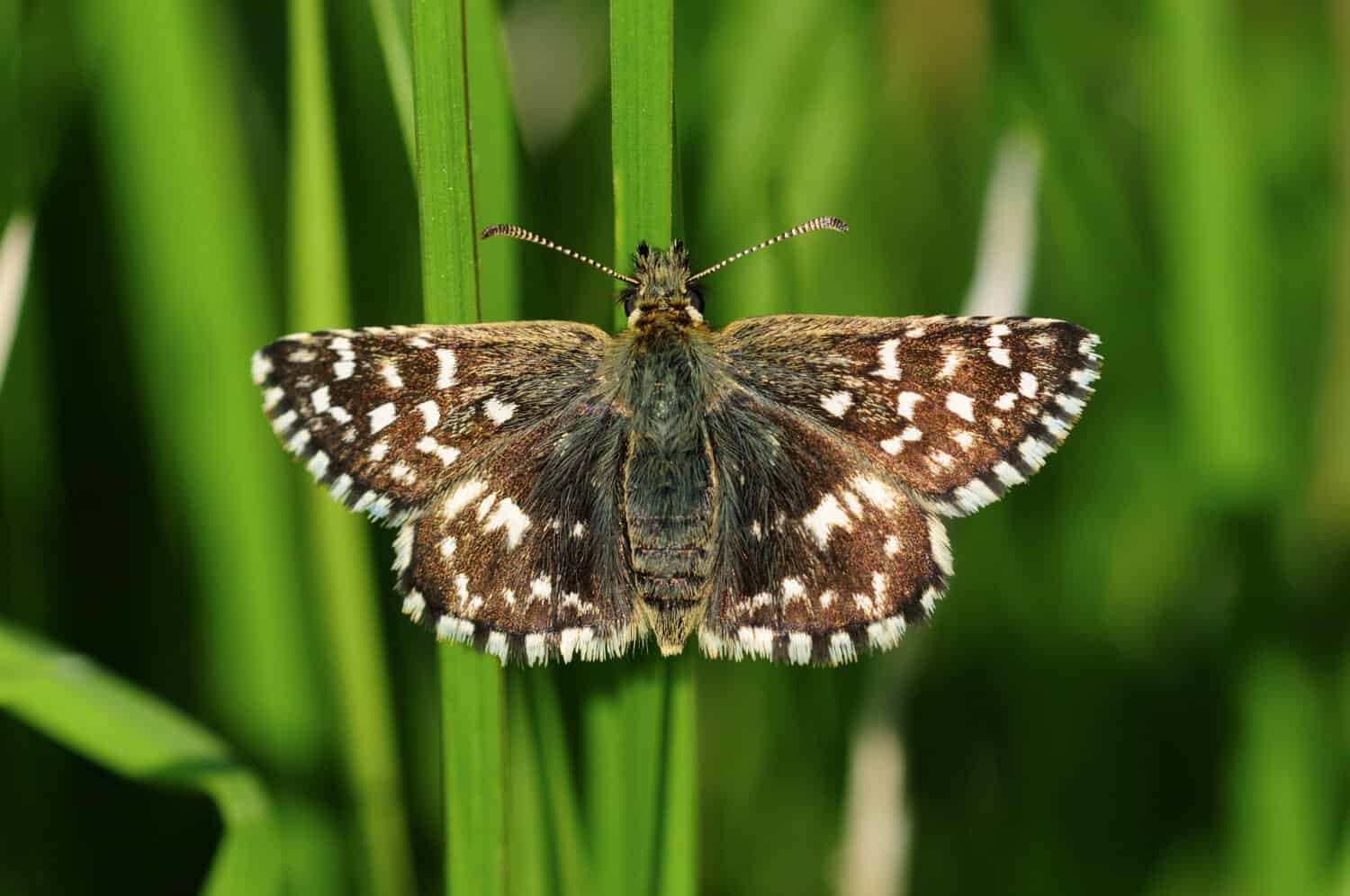
A grizzled skipper butterfly resting on greenery.
©colin robert varndell/Shutterstock.com
White Morpho
White morpho butterflies live in Mexico and Central America. They are almost entirely white with a few small black or brown spots across their open wings. These large butterflies are very rare to find and have wingspans that vary from 4.5 to 5.75 inches.

White morpho butterflies are almost completely white with a few black spots.
©Ondrej Prosicky/Shutterstock.com
Margined White
Margined white butterflies live across western North America, from New Mexico through Canada and into Alaska. They have white bodies with black wing veins. They have a wingspan of 1.5-2.25 inches.

Margined white butterflies are mainly white with black wing veins.
©Lovely Bird/Shutterstock.com
Weidemeyer’s Admiral
Weidemeyer’s admiral butterflies live across western North America. They are recognizable by their stark black coloring with a white median band that runs horizontally across their bodies. They have white spots that run along the bottom of their wings. These butterflies have a wingspan of 2.25 to 3.75 inches.
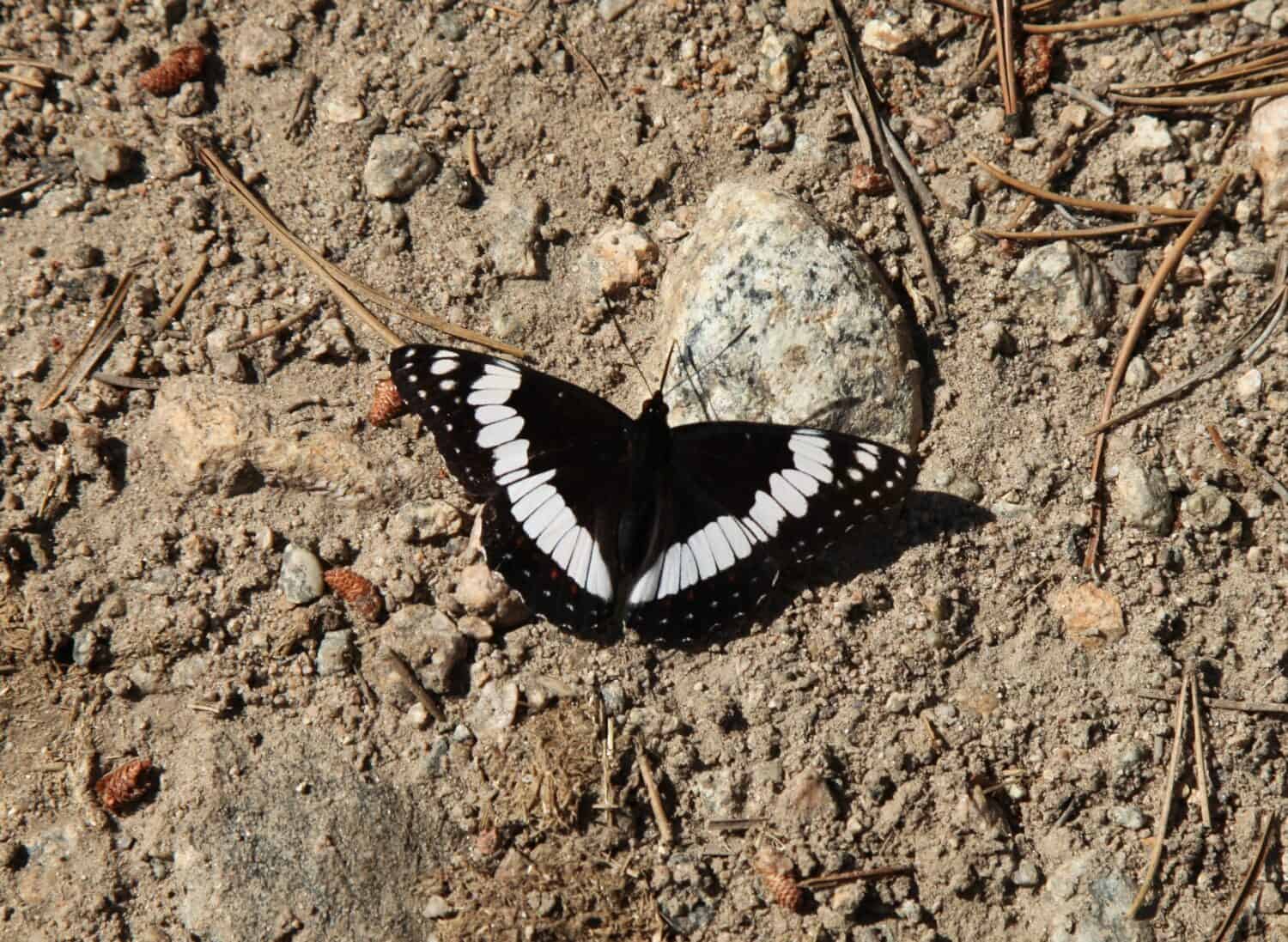
Weidemeyer’s admiral butterflies are known for their dark black coloring and large white band.
©Nikki Yancey/Shutterstock.com
Common Pierrot
The common pierrot butterfly is found across Asia, mainly in India. These butterflies are white with many black spots, similar to cheetah prints. They usually have a black outline around their wings. They are small butterflies with an average wingspan of 0.9 to 1.3 inches.
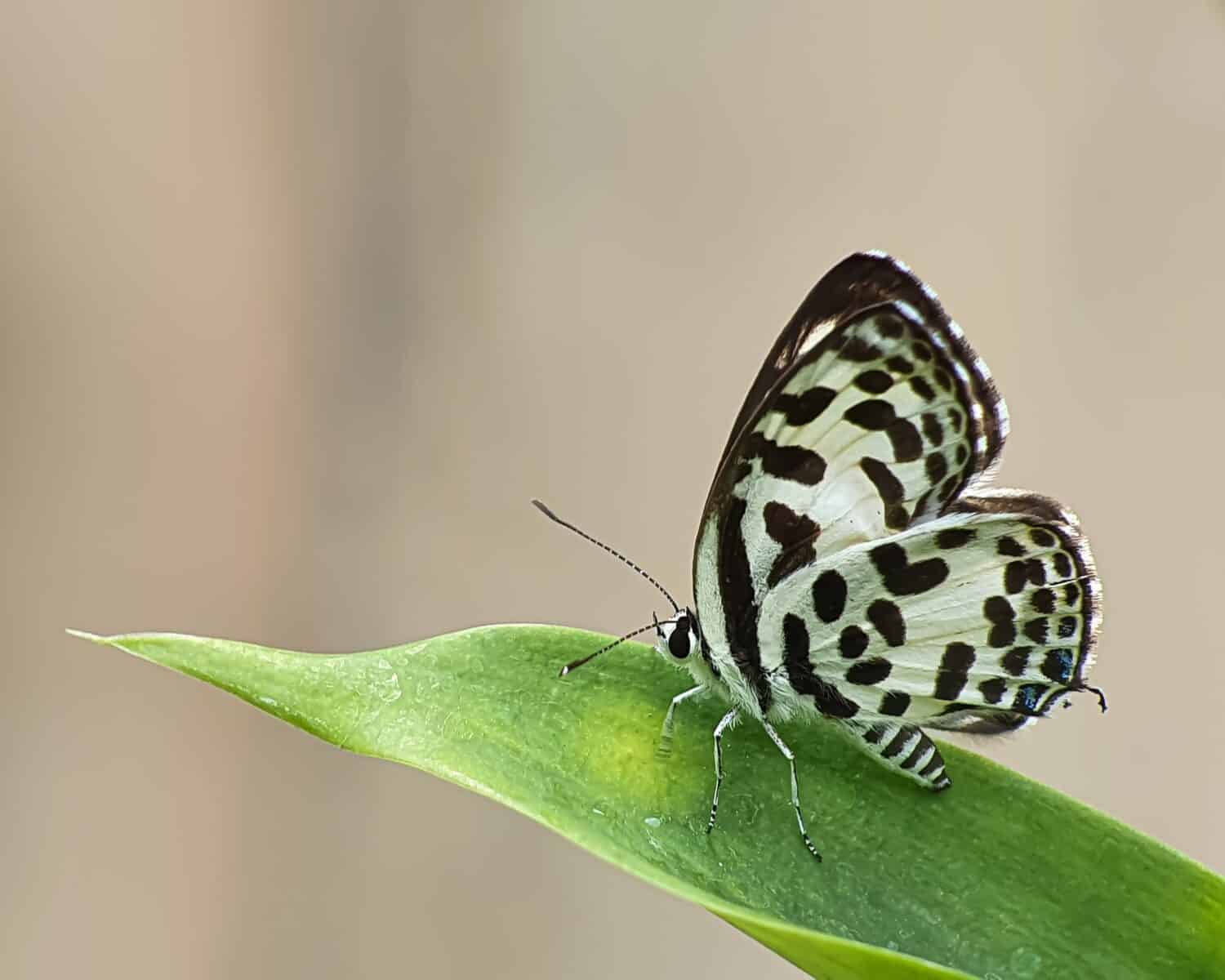
Common pierrots have a cheetah-like pattern of spots.
©Eva Syarkawie/Shutterstock.com
Elbowed Pierrot
Similar to the common pierrot, the elbowed pierrot species is found across Asia, with most in India. Viewed from above, they are mostly black with a large white median band, but from the side, they are white with large black spots. They have an average wingspan of 0.8 inches.

Elbowed pierrots are similar in color to their relative, the common pierrot.
©Nuwat Phansuwan/Shutterstock.com
Clodius Parnassian
These butterflies live in the western U.S. and parts of southwest Canada. They are mainly white with gray and black shading across their open wings. They also have two small red spots on each wing. Clodius parnassian butterflies are medium-sized with a wingspan of 2 to 2.5 inches.
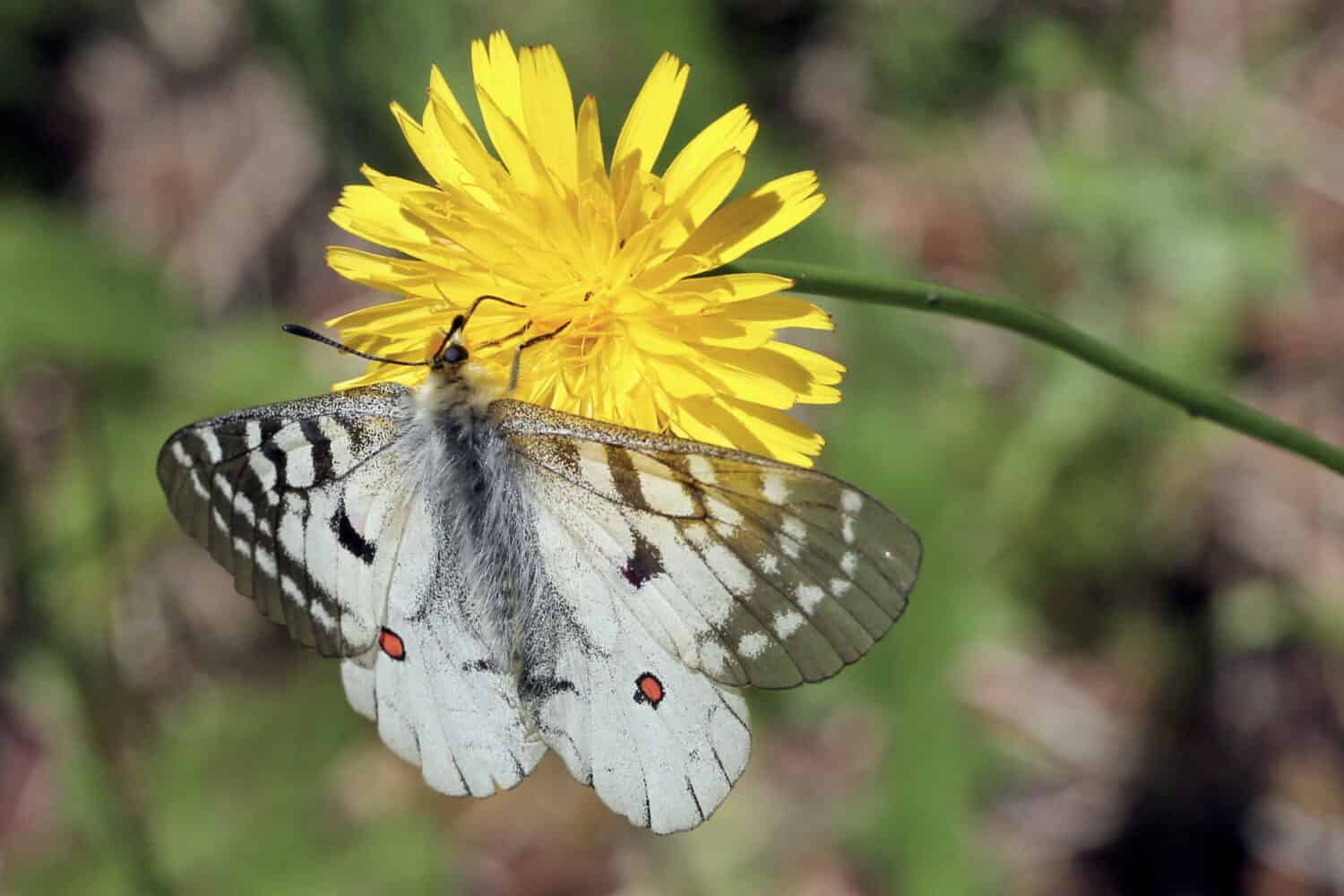
Clodius parnassian butterflies are mainly white with black shading and two red dots.
©Randy Bjorklund/Shutterstock.com
Malabar Tree-Nymph
This large butterfly species is found across India. They are white with black wing veins and many medium-sized black spots. Their wingspan is between 4.7 and 6.1 inches.
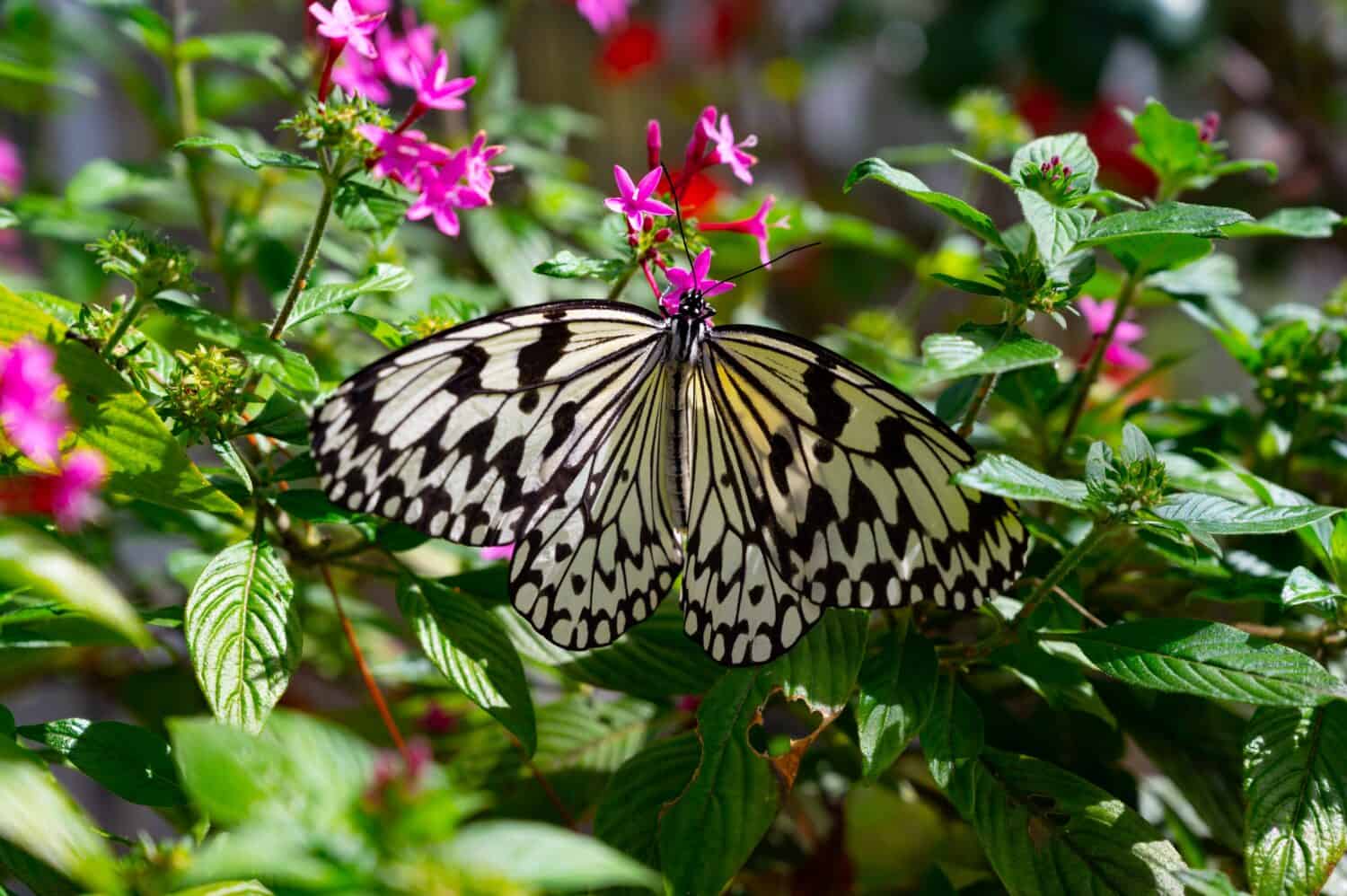
Malabar Tree-Nymph sipping nectar from a pink flower.
©Rebecca Lambertsen/Shutterstock.com
Common Sailor
The common sailor species lives across India and other parts of southeast Asia. They are black with white stripes and spots. They have an average wingspan of 2 inches.

Common sailors live across India and southeast Asia.
©BegawanStudio/Shutterstock.com
Pine White
Pine white, or pine butterflies live across the western U.S. and southwest Canada. They are all white with black wing veins and black wing tips. True to their name, they often live in pine forests. They have a wingspan of 1.75 to 2.25 inches.
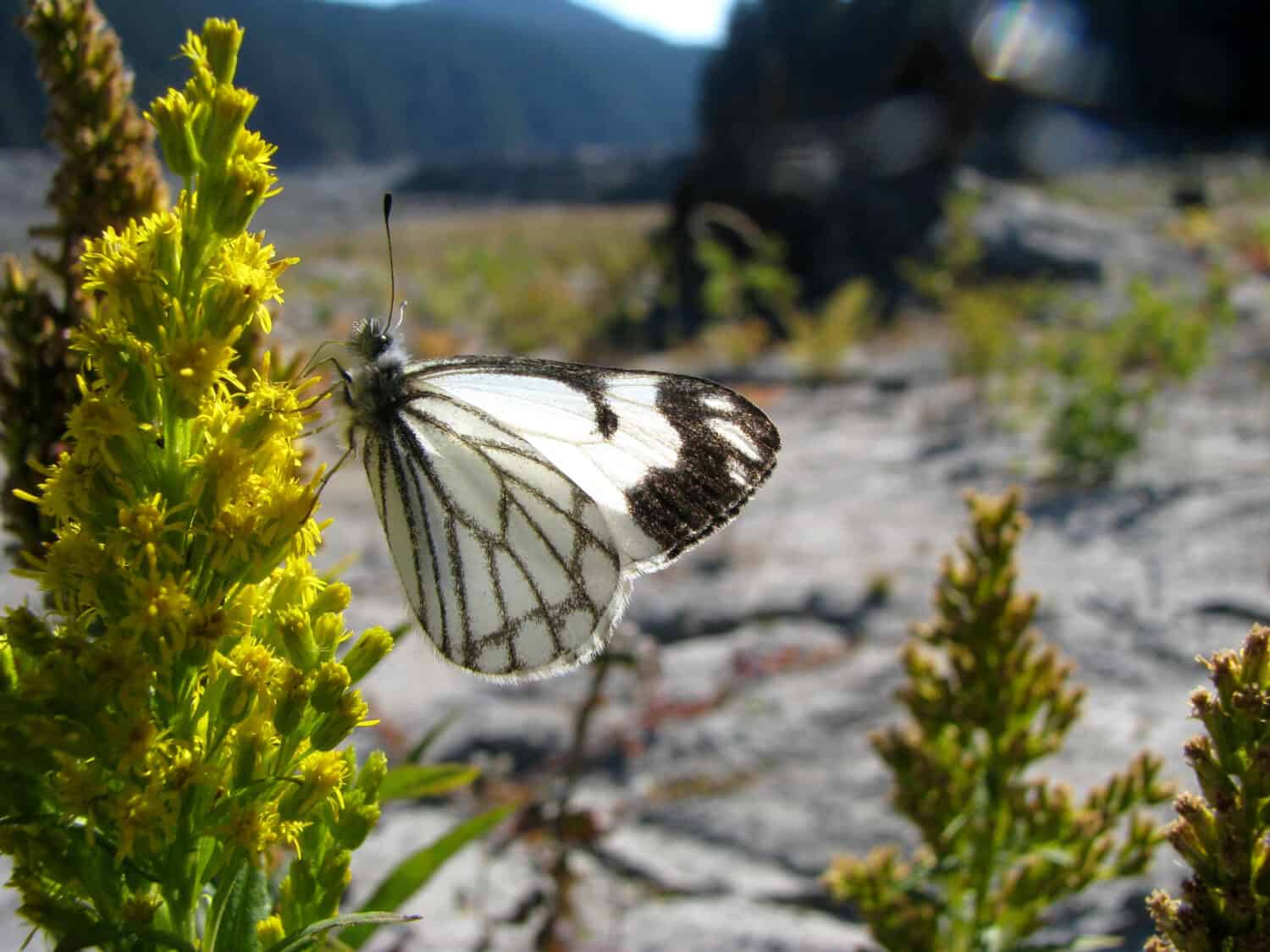
Pine white butterfly feeding on goldenrod outside of a pine forest.
©Photo_Rollick/Shutterstock.com
Antiochus Longwing
These butterflies live in parts of Panama to the Amazon region of South America. They are black with two wide white stripes that run horizontally across their forewings. They have a wingspan of 2 inches.
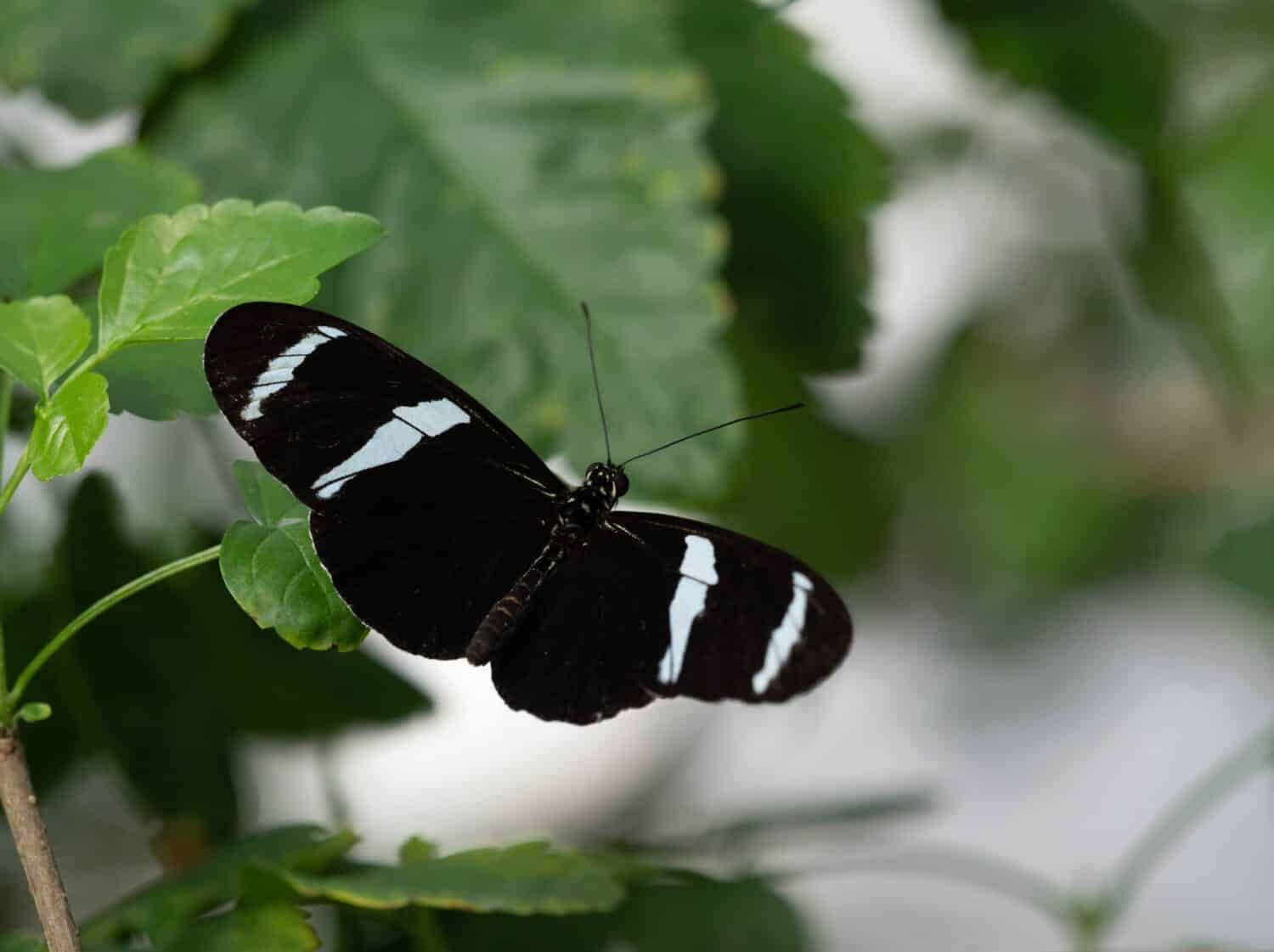
An antiochus longwing butterfly perched on a green leaf.
©Teresa Otto/Shutterstock.com
Desert Marble
The desert marble is located across the western portion of the U.S. and into parts of northern Mexico. Their open wings are white with a few black markings closer to the edges of their forewings and gray bodies. Their wingspan is around 1.5 inches.
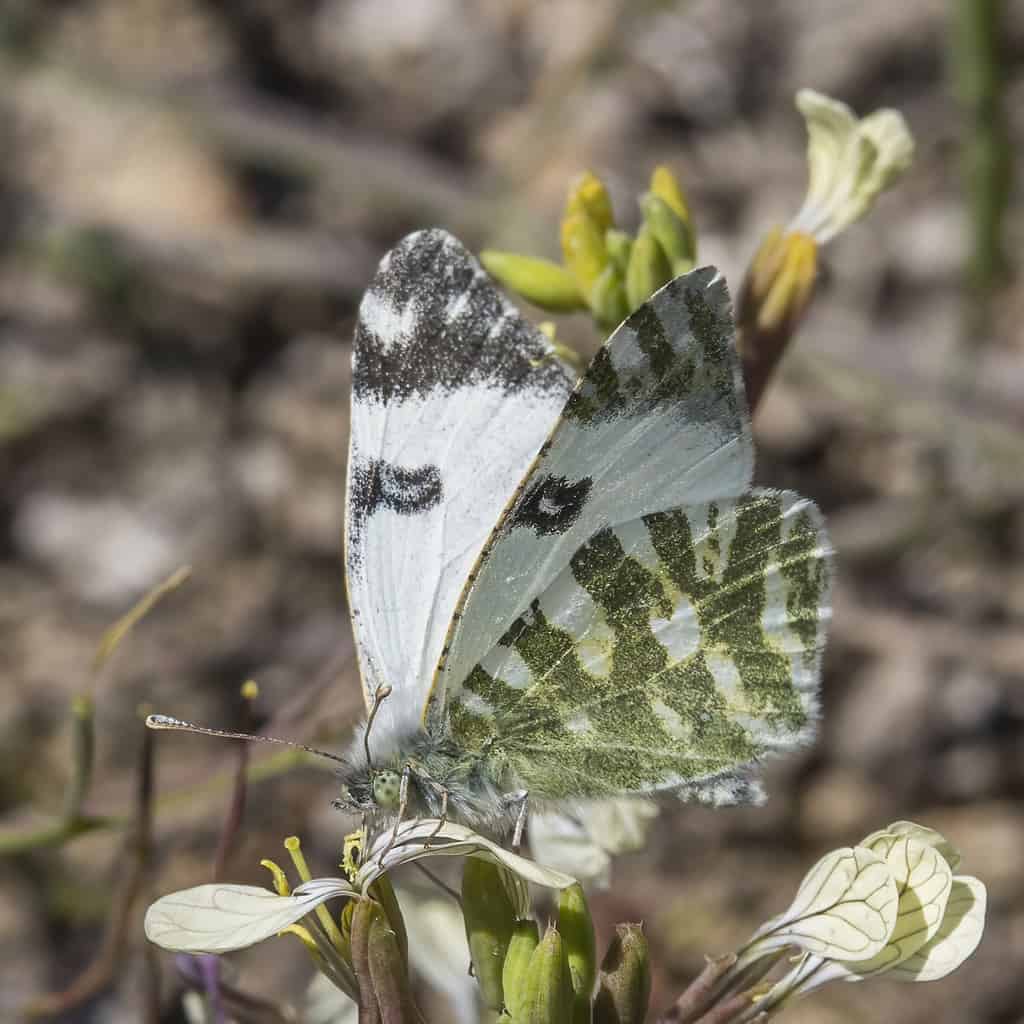
Desert marble butterfly resting on greenery.
©Charles J. Sharp / CC BY-SA 4.0 – License
Chiricahua White
The Chiricahua white, also known as the Mexican white pine butterfly is found throughout Mexico and some southwest U.S. states. Their open wings are white with black wing veins and black edges on their forewings. Only the males of this species are black and white, and the females are black and orange. Their wingspan varies from 1.75 to 2.25 inches.

The Chiricahua white, also known as the Mexican white pine butterfly is found throughout Mexico and some southwest U.S. states.
©Unspecified, Colorado State University / CC BY 3.0 – License
Arctic White
The arctic white species of butterfly are found throughout northwest Canada and Alaska. They are one of the less-common types of butterflies that live in cold climates. Their wings are mostly white from above, with a black body and black wing veins. They have a wingspan of 1.3 to 1.7 inches.

An arctic white butterfly resting on a purple flower.
©Walter Siegmund / CC BY-SA 3.0 – License
What Does it Mean When a Black and White Butterfly Visits You?
The presence of a black and white butterfly can be a symbol that it’s time to seek peace in your life. This might involve resolving ongoing conflicts with family members, friends, or colleagues. Remember, true peace often begins within yourself.
Additionally, the presence of black and white butterflies in dreams suggests a need to focus on inner peace and balance. While temporary balance is achievable, the key is to sustain it over time. The symbolism of black and white signifies the measured approach required to navigate life’s challenges.
Maintaining this balance becomes especially vital during difficult times, where the ability to stay calm and make rational decisions is crucial.
The photo featured at the top of this post is © David Jeffrey Ringer/Shutterstock.com
Thank you for reading! Have some feedback for us? Contact the AZ Animals editorial team.




